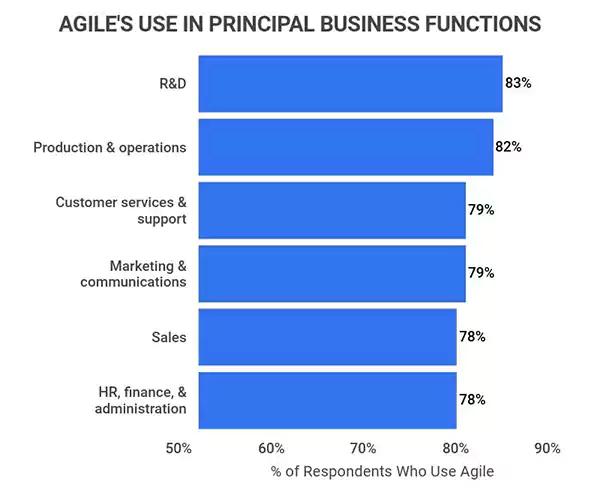How Agile Development Can Increase Your ROI?
Key Takeaway
- Agile development is a flexible and iterative software development approach that emphasizes collaboration, adaptability, and continuous improvement. It enables fast delivery of high-quality software.
- It promotes the formation of self-organizing, cross-functional teams that consist of members with diverse skill sets.
- Agile teams emphasize frequent integration of code changes and continuous delivery of working software. It also places a strong emphasis on collaboration and effective communication among team members and stakeholders.
In the current rapidly evolving digital landscape, businesses strive to maximize their Return on Investment (ROI) by leveraging cutting-edge technologies and efficient development methodologies. One such approach that has gained immense popularity is Agile.
As illustrated in the graph below agile is used in the principal business functions and interestingly about 71% of the U.S. companies are now using it.

In this blog post, we’ll explore how Agile development, coupled with custom software development services, can significantly enhance your ROI and give your business a competitive edge. So, let’s dive in!
Agile Development: A Game-Changer for ROI:
Agile development is a flexible and iterative program enhancement approach that emphasizes collaboration, adaptability, and continuous improvement. By breaking down projects into smaller, manageable increments called sprints, Agile enables faster delivery of high-quality software.
This iterative approach minimizes risks and allows for early feedback and course corrections, ensuring that the final product aligns with customer expectations.
The following are the key components of agile development:
Iterative Development
Agile projects are divided into smaller iterations or timeboxed periods called “sprints.” Each sprint typically lasts from one to four weeks and aims to deliver a working increment of the software. The team focuses on completing a set of prioritized user stories or requirements within each sprint.
Cross-Functional Teams
Agile promotes the formation of self-organizing, cross-functional teams that consist of members with diverse skill sets. These teams usually include developers, testers, designers, and product owners who collaborate closely throughout the development process.
User Stories and Backlog
It relies on user stories, which are brief, non-technical descriptions of desired features or functionality from the user’s perspective. These user stories are captured and prioritized in a backlog, a dynamic list of requirements that can be adjusted and reprioritized throughout the project.
Continuous Integration and Delivery
Agile teams emphasize frequent integration of code changes and continuous delivery of working software. Developers integrate their code changes frequently into a shared repository, ensuring that the program remains in a functional state at all times. Continuous integration helps identify and resolve integration issues early in the development cycle.
Collaboration and Communication
Agile places a strong emphasis on collaboration and effective communication among team members and stakeholders. Daily stand-up meetings are held to synchronize progress, discuss challenges, and plan the day’s work. Regular sprint reviews and retrospectives facilitate feedback, learning, and process improvement.
Interesting Fact: ROI as a performance measure helps to scale the efficiency of investment while in economic terms it is one way of relating profit to capital invested.
Customized Software Development: Tailoring Solutions to Your Needs:
When it’s about maximizing ROI, off-the-shelf software solutions may not always fit your business requirements perfectly. This is where customized software development services come into play.
By designing and developing tailored program solutions that address your specific pain points and align with your business goals, you can achieve a higher level of efficiency, productivity, and ultimately, ROI. Custom software offers the flexibility to adapt and scale as your business evolves, giving you a competitive advantage.
Streamlined Communication and Collaboration:
Agile development places a strong emphasis on collaboration between stakeholders, including developers, designers, product owners, and end-users. Regular meetings, such as daily stand-ups and sprint reviews, facilitate effective communication, ensuring everyone is aligned and working towards a shared vision.
This streamlined collaboration leads to a more efficient development process, reducing time wastage and enhancing productivity.
Faster Time-to-Market
In the current fast-paced business environment, time-to-market is imperative. Agile development enables faster delivery of software by breaking down complex projects into smaller, manageable tasks.
The iterative nature of Agile ensures that valuable features are released early and continuously refined based on user feedback. By launching your custom software sooner, you can gain a competitive edge, attract early adopters, and start generating ROI at an accelerated pace.
Interesting Fact: Companies using Agile have found up to 60% of growth in revenue and profit, while the most popular Agile framework is Scrum.
Enhanced Quality and Adaptability:
Agile development emphasizes regular testing and feedback loops, ensuring that software quality remains high throughout the development process. By addressing issues and comprising user feedback at each iteration, you can refine your program and meet evolving market demands effectively.
This adaptability helps you stay ahead of the competition, boost customer satisfaction, and ultimately increase your ROI.
Mitigating Risks:
Agile development employs an incremental approach, enabling you to identify and mitigate risks early in the enhancement cycle. By continuously evaluating project progress and adapting accordingly, you can minimize costly mistakes and ensure that the final product meets customer expectations.
This risk mitigation capability not only protects your investment but also allows you to allocate resources more efficiently, resulting in higher ROI.
Conclusion
Embracing Agile development, along with custom software development services, can unlock significant ROI software potential for your business. By leveraging the flexibility, collaboration, and iterative nature of Agile, coupled with tailored software solutions, you can streamline growth, achieve faster time-to-market, enhance quality, mitigate risks, and ultimately maximize your ROI.
So, take the leap towards Agile development today and propel your business to new heights of success!








